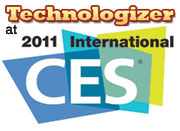CES 2011: T-Mobile's Tablets and Network Upgrade
By Jacqueline Emigh | Saturday, January 8, 2011 at 6:46 am

Dell Streak 7
 T-Mobile USA has rolled out new tablets from Dell and LG, a new USB stick for upping end users’ access times, and intends to double the speed of its underlying network, all in the face of intensifying 4G wireless competition from Verizon, Sprint and AT&T.
T-Mobile USA has rolled out new tablets from Dell and LG, a new USB stick for upping end users’ access times, and intends to double the speed of its underlying network, all in the face of intensifying 4G wireless competition from Verizon, Sprint and AT&T.
In announcing the availability of the Android 2.2-based Dell Streak 7 tablet over the next few weeks during a CES news conference, T-Mobile also gave quick sneak peeks at a second tablet, dubbed the G Slate, and the new speed stick from ZTE.
At a press reception afterward on Thursday night, I did a bit of hands-on with the Streak 7, while getting perspectives from a couple of T-Mobile engineers about how T-Mobile’s network stacks up against the rivals.
The G Slate and new 42 Mbps USB speed stick were both absent at the reception, however. A spokesperson told me that T-Mobile is keeping both devices away from close-up scrutiny for the moment, since the gear is still under development. The G Slate is T-Mobile’s emerging version of LG’s Honeycomb tablet.
As you might expect, the Streak 7 looks like a jumbo edition of Dell’s Streak 5 phone-tablet. If you like a larger screen, you’ll obviously get that in the Streak 7, but the Streak 7 lacks the Streak 5’s voice calling capabilities.
The Streak 7 sports a dual-core Nvidia Tegra 2 processor, Swype navigation, and rear- and front-facing cameras. The front-facing camera supports Qik video conferencing.
The Android-based tablet also supports Android Market, of course, although T-Mobile only loaded the Streak with a few applications for the press demos, including Angry Birds and a T-Mobile user access test app.
The touch screen seemed admirably responsive when I used it to play around with Android Market and the test app. In test results, I came up with 3103 Kbps on the downlink and 1143 Kbps on the uplink over T-Mobile’s existing network.
Brian Olsen, a senior technology engineer at T-Mobile, told me that test results had been better earlier in the day, but that latency seemed to be increasing with the convergence of more and more techies upon Las Vegas.
Notably, though, elsewhere in and around CES, people keep complaining that the wireless networks of Verizon, Sprint and AT&T are getting bogged down, too.
T-Mobile already offers a USB speed stick, but the current stick supports network speeds of only 21 Mbps.
Meanwhile, T-Mobile plans to double the speed of its underlying network by bonding new HSPA+ cell towers with existing ones. T-Mobile is dubbing its new network HSPA+ 42, said Mark McDiarmid, T-Mobile’s senior director of engineering and operations, in an interview at the press reception.
The carrier expects to start the network upgrade in its top 25 US markets, later expanding to the remaining top 100 markets, all of which now have 3G in place.
T-Mobile’s network upgrade strategy is quicker and more cost effective than the approaches Verizon is taking with LTE and Sprint is following with WiMax, because unlike the others, T-Mobile doesn’t need to install new types of cell towers, McDiarmid said.
Speeds on T-Mobile’s HSPA+ 42 network will be comparable to those of Verizon’s LTE 4G network, according to the engineer.
Also, since T-Mobile isn’t building a whole new network architecture, its sped up network will be backward compatible with older tablets and phones, meaning that end users won’t need to buy new devices, he told me.
2 Comments
Read more:













January 8th, 2011 at 6:59 am
nice tablet. love it 🙂
January 8th, 2011 at 7:57 am
All this would be nice if I had T-Mobile service. (But I'm more than 600 yards from the centerline of the nearest highway…their network is very thin out here in the boonies.)